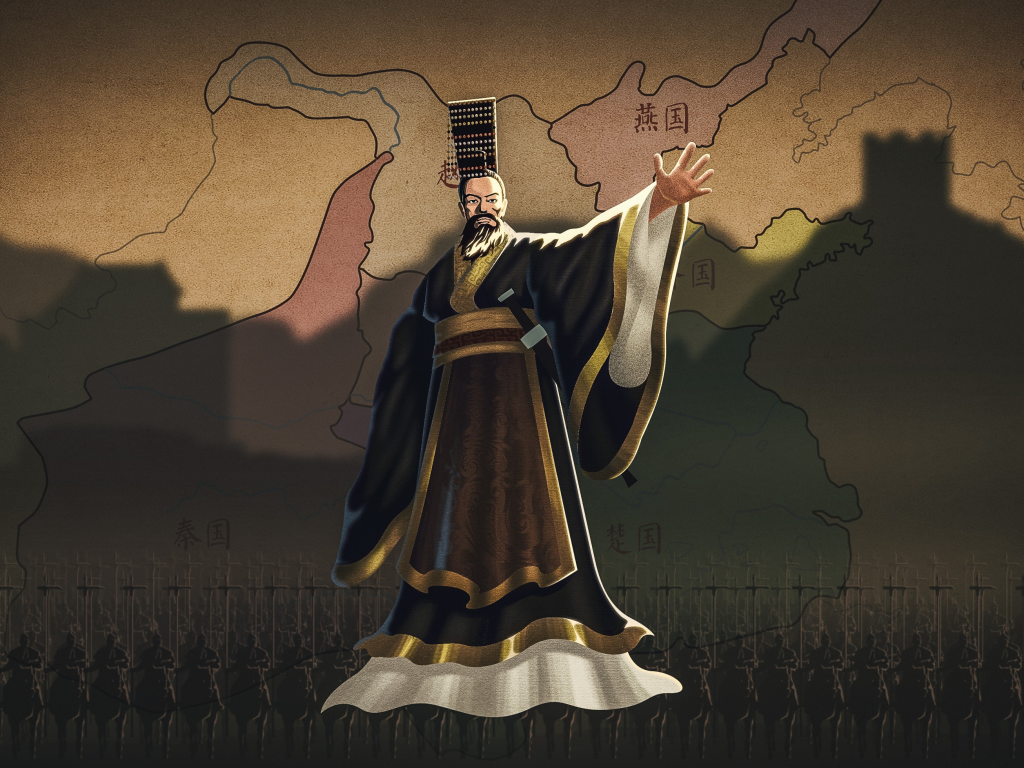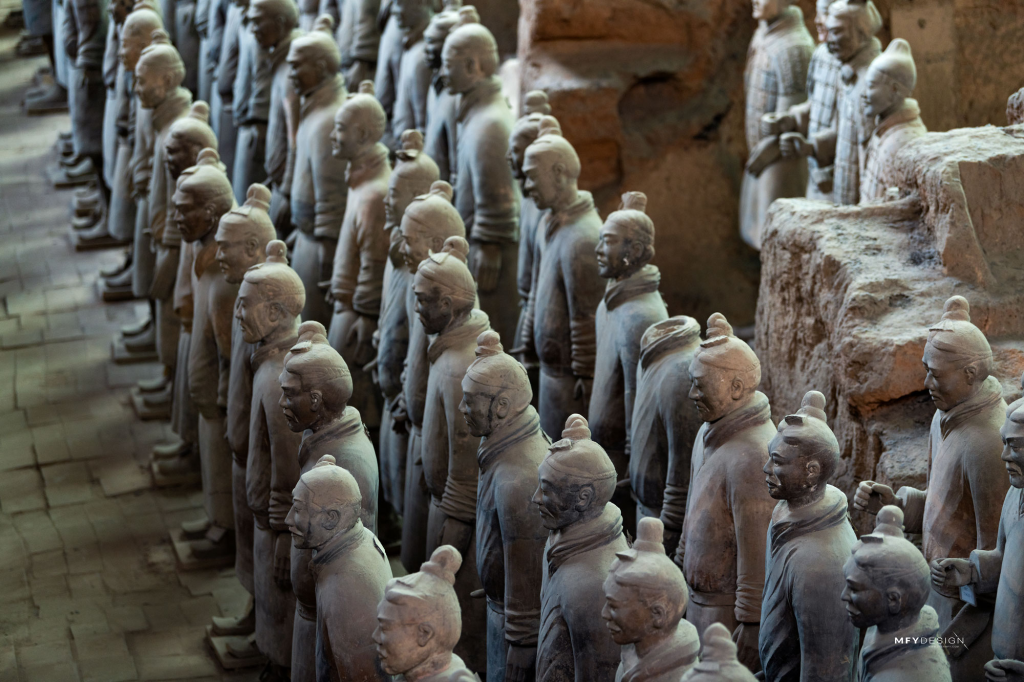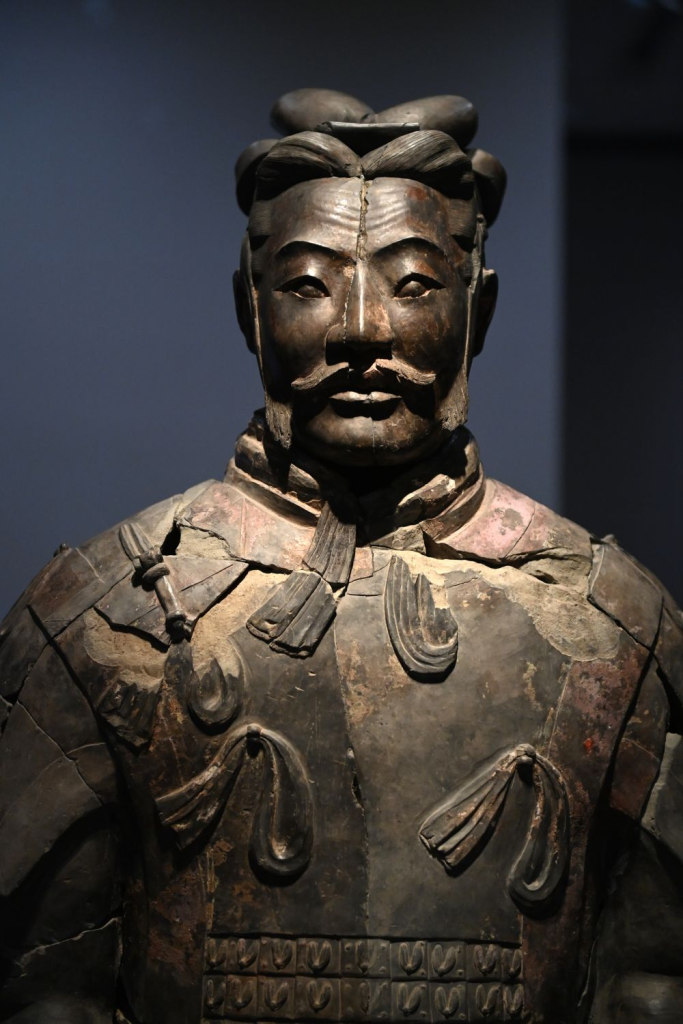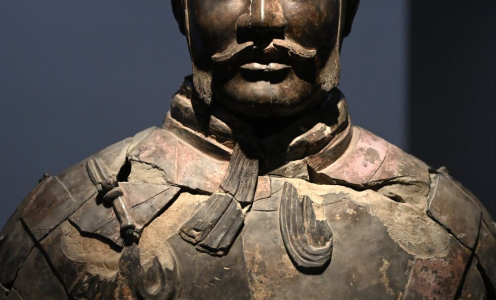The Terracotta Warriors, a UNESCO World Heritage Site and one of the most breathtaking archaeological discoveries of the 20th century, stands as a silent guard over a world kept secret. These thousands of life-size clay soldiers, horses, and chariots offer a glimpse into the power and majesty of ancient China. Their very existence whispers stories of a powerful emperor, a unified nation, and a belief system extending beyond the mortal realm. 🤯
Qin Shi Huang: The Emperor and His Vision

The story begins with Qin Shi Huang , the first Emperor of a unified China. Imagine a leader so ambitious and driven that he not only conquered warring states but also standardized weights, measures, currency, and even the written language. At the young age of thirteen, he ascended the throne of the Qin State, and his vision for an immortal legacy began to take shape.
His grand mausoleum was not just a tomb but an entire underground palace, a reflection of his earthly power extending into eternity. The building project was a massive undertaking involving hundreds of thousands of workers, artisans, and craftsmen. The sheer magnitude of the project speaks volumes about the emperor’s authority and available resources. He envisioned a subterranean kingdom, complete with rivers of mercury, constellations painted on the ceiling, and, of course, an army to protect him from any threat, even death.
- Unification and Standardization: Qin Shi Huang’s most significant achievement was unifying the seven warring states into a single empire. He implemented a centralized government, replacing feudal structures with a system of commanderies and prefectures. He standardized laws, weights, measures, and currency, facilitating trade and communication across the empire.
- The Legalist Philosophy: The Qin dynasty was guided by Legalism, a philosophy emphasizing strict laws, harsh punishments, and absolute obedience to the ruler. This philosophy enabled the emperor to maintain control over a vast and diverse population.
- Infrastructure Projects: Qin Shi Huang initiated numerous infrastructure projects, including the construction of a vast network of roads and canals, facilitating trade and military movements. He also connected and extended existing walls, forming the early version of the Great Wall of China.
The Accidental Discovery
In 1974, a group of farmers digging a well near Xi’an in Shaanxi province made a discovery far more important than water. They unearthed fragments of terracotta, which would later be recognized as one of the most remarkable archaeological finds in history.
Imagine their surprise! They had been searching for a life-sustaining water source but instead found the remains of a long-lost army frozen in time. Initial excavations quickly revealed the magnitude of the discovery. It wasn’t just a few statues; it was an entire legion, meticulously arranged in battle formation, ready to defend their emperor for all eternity. The news spread like wildfire, captivating archaeologists, historians, and the general public. This was a window into a world shrouded in mystery for over two millennia.
The Afterlife and the Army’s Purpose

Why construct such a complex army of clay? The answer lies in ancient Chinese beliefs about the afterlife. Emperor Qin Shi Huang, like many rulers of his time, believed that death was a transition to another realm, a continuation of existence where he would still require the trappings of power and protection.
The Terracotta Warriors were not merely symbolic; they were intended to be a fully operational army, capable of protecting the emperor from any spiritual foes. This belief system highlights the profound significance of burial practices in ancient China. Tombs were not just resting places for the dead; they were homes for the soul, furnished with everything required for a comfortable and secure afterlife.
- The Concept of the Soul: Ancient Chinese beliefs about the soul were complex and varied. Generally, it was believed that a person had multiple souls, some of which ascended to the heavens while others remained with the body in the tomb. Ensuring the well-being of these souls was crucial for the deceased’s continued existence in the afterlife.
- Burial Goods: Tombs of wealthy individuals were filled with burial goods, including food, clothing, jewelry, and other items considered necessary for the afterlife. The quantity and quality of these goods reflected the deceased’s status and wealth in life.
- Filial Piety: Filial piety, or respect for one’s ancestors, was a cornerstone of ancient Chinese culture. Elaborate burial rituals and the construction of elaborate tombs were seen as expressions of filial piety, ensuring the deceased’s happiness and well-being in the afterlife.
Craftsmanship and Mastery
The sheer magnitude of the Terracotta Army is astounding. Over eight thousand soldiers, each unique, accompanied by horses, chariots, and a collection of real bronze weapons. Imagine the logistical challenge of creating such a vast army, not from a mold but with individual characteristics. The ancient Chinese artisans’ skill and organization are a testament to their incredible skill and organization. 🎨
The figures were molded from local clay and then fired in kilns. Afterward, they were painstakingly painted with vibrant colors, most of which have faded over time. The techniques employed demonstrate a sophisticated understanding of materials and methods for the time. The warriors were constructed using a modular approach, with each body part created separately before assembly. This allowed for mass production while ensuring each figure had its own unique personality.
- Individualized Features: Although the bodies were created using molds, the faces of each soldier were sculpted by hand, resulting in unique expressions and features. It’s believed that the artisans may have used real soldiers as models, capturing a diverse range of facial characteristics.
- Lost Colors: Originally, the warriors were painted in vivid colors, including red, green, blue, purple, and yellow. Unfortunately, the paint deteriorated upon exposure to air and light, leaving most figures with the muted terracotta color we see today. Scientists are working to preserve the remaining pigments and potentially restore some of the lost color.
- Bronze Weaponry: The Terracotta Army was armed with a variety of real bronze weapons, including swords, spears, crossbows, and arrowheads. These weapons were not merely for display; they were functional and deadly. The crossbows, in particular, were a remarkable technological advancement for their time.
- Artisans and Laborers: It is believed that 700,000 people put in their labor for the completion of the tomb. It is highly likely that the artisans and laborers who performed their duties on this project were conscripted from all over the empire. Their work was not only a demonstration of their expertise and commitment, but it also served as a reflection of the emperor’s unquestionable authority. It is not only an army that they created, but also a work of art that continues to amaze and motivate people even after centuries have passed.
Insights and Mysteries

The Terracotta Warriors offer invaluable insights into the art, technology, and military practices of ancient China. By examining their weapons, armor, and battle formations, we can learn about how wars were fought during the Qin Dynasty. The intricate details of their hairstyles, clothing, and facial expressions provide a wealth of information about social hierarchy and cultural norms.
In addition to its military aspects, the army is a rich source of artistic and technological knowledge. The intricate craftsmanship of the figures, the use of bronze for the weapons, and the sheer scale of the project all demonstrate the advanced capabilities of ancient Chinese civilization.
- Military Organization: The arrangement of the warriors in battle formation provides clues about the Qin army’s tactics and organization. The presence of different types of soldiers, including infantry, cavalry, and charioteers, reflects the diverse composition of the army.
- Social Hierarchy: The clothing and hairstyles of the warriors reflect social hierarchy within the army. Higher-ranking officers are distinguished by their more elaborate attire and headgear.
- Artistic Techniques: The Terracotta Army demonstrates advanced sculpting, molding, and firing techniques. The modular construction method allowed for efficient production while maintaining a degree of individualization.
- Mysteries: Archaeologists do not know how the weapons were able to maintain such a high level of preservation for such a long period of time. Not only that, but the army continues to be a mystery to them.
Preservation and Discovery
Ongoing archaeological excavations are taking place at the Terracotta Army site. New discoveries are constantly being made, revealing even more about this extraordinary complex. The warriors, vulnerable to air and environmental factors, require constant care and delicate treatment.
Preservation efforts are a significant undertaking. Scientists and conservators are working to develop techniques to stabilize the remaining pigments, prevent further deterioration, and protect the figures from the elements.
- Challenges of Preservation: The Terracotta Warriors face numerous threats, including humidity, temperature fluctuations, and air pollution. The paint on the figures is particularly fragile and requires careful stabilization.
- Conservation Techniques: Conservators use a variety of techniques to preserve the Terracotta Warriors, including cleaning, consolidation, and reassembly. They also work to create a stable environment to protect the figures from further damage.
Visiting the Terracotta Army
The Terracotta Warriors have become a major tourist attraction, drawing visitors from around the world. Standing in the presence of these silent sentinels, it is impossible not to be moved by their scale, artistry, and historical significance. You can sense the past, the reverberations of a powerful empire, and the ambitions of an emperor who sought immortality.
If planning a visit, consider going during the shoulder seasons (spring and autumn) for more pleasant weather and fewer crowds. A guided tour is highly recommended for insightful information and valuable context. Visit nearby attractions such as the Mausoleum of Emperor Qin Shi Huang (largely unexcavated) and the city of Xi’an.
Actions to take while you are there:
- Go on a tour with a guide.
- Come during a time of year when there are fewer tourists.
- Take a look at the gift shop!
- Learn about the other attractions in the area.
A Lasting Legacy
The Terracotta Warriors are more than just clay figures; they are a testament to the power, artistry, and enduring legacy of ancient China. They represent the birth of a unified empire and the ambition of a ruler who sought to conquer not only the earthly realm but also the afterlife.
Their discovery was a pivotal moment in archaeology, and ongoing research continues to offer invaluable insights into a civilization that profoundly shaped human history. They remind us that the stories of those who came before us can still captivate and inspire us, even after thousands of years. They stand as a testament to the enduring power of the past, an invitation to explore the intricate tapestry of human history. It would be a shame to pass up the opportunity to experience this extraordinary marvel for yourself! ✨
Additional Insights

- Facial Features: Despite the fact that the bodies of the warriors were created by using molds, the faces of each soldier were sculpted by hand, which resulted in each soldier having a distinct appearance. Those who are knowledgeable in the field believe that the artisans may have used actual soldiers as models, thereby capturing a wide variety of facial features and expressions. A remarkable human element is added to the army by the level of detail that has been added.
- The Lost Colors: When the warriors were first discovered, many of them still had remnants of the vibrant paint that had been there when they were first painted. They were decked out in vivid colors such as red, green, blue, purple, and yellow, which resulted in a spectacle that was absolutely breathtaking to observers. Unfortunately, the paint quickly deteriorated as a result of being exposed to air and light, which resulted in the majority of the figures having a muted terracotta color that we see today. Methods are currently being developed by scientists in order to preserve the pigments that are still present and possibly restore some of the color that has been lost.
- Bronze Weaponry: The Terracotta Army was armed with a wide variety of real bronze weaponry, such as swords, spears, crossbows, and arrowheads. This was a significant advantage in terms of military capabilities. The weapons in question were not merely for display; rather, they were both practical and lethal. For their time, the crossbows in particular were a remarkable technological advancement because they were able to fire arrows with a great deal of precision and force. The discovery of these weapons offers significant insights into the military technology that was utilized by ancient Chinese armed forces.
- More Than Just Soldiers: There is more to the Terracotta Army than just its soldiers; it is not just about soldiers. In addition, the pits contain terracotta horses, chariots, acrobats, musicians, and officials, which offer a glimpse into the more general society that existed during the Qin Dynasty. These individuals provide insights into the structure of the imperial court as well as daily life and entertainment from the time period.
- Emperor Qin Shi Huang’s Mausoleum: The mystery surrounding the mausoleum is that the actual tomb of Emperor Qin Shi Huang, which is situated close to the Terracotta Army, has not been excavated to a significant extent. The tomb is said to have a vast underground palace that is brimming with treasures, rivers of mercury, and intricate traps to deter grave robbers, as stated in ancient texts. According to the historical records, the mausoleum is described as being of substantial size and complexity, which suggests that it may contain even more remarkable wonders than the Terracotta Army itself.
- Unsung Laborers: Despite the fact that the artisans who crafted the warriors are frequently honored, the enormous labor force that was responsible for building the entire mausoleum complex is frequently disregarded during the construction process. The excavation of the pits, the transportation of materials, and the construction of the underground structures were all tasks that were performed by hundreds of thousands of conscripted laborers over the course of year. The contribution that they made was absolutely necessary for the development of this monumental project.
- European Ancestry: Several recent genetic studies have been conducted on the remains that were discovered within the mausoleum complex. These studies have revealed some fascinating insights into the workforce. Some of the remains have been found to have European ancestry, which suggests that there may have been contact and exchange between China and the West much earlier than was previously believed.
- Continual Discoveries: It was in the year 2022 that archaeologists discovered twenty additional figures, which is an example of a new discovery. The fact that new information and statistics are being disclosed on a regular basis demonstrates how much more there is to learn.
A Location Worth Investigating
Visit the Terracotta Army if you have the chance. There is an incredible amount of things to see and do. You can go to the museum that has been established, or you can check out some of the other attractions in the area! In addition to the town of Xi’an, which is home to the Terracotta Warriors, there are a great deal of other historical sites that you can visit. The Great Mosque, the Big Wild Goose Pagoda, the ancient city wall, and, of course, the Mausoleum of Emperor Qin Shi Huang are all examples of important building structures. By incorporating these additional details, the copy expands upon the core information, thereby providing a picture that is more comprehensive and engaging of the Terracotta Warriors and the historical context in which they were created. The use of bullet points makes the information simple to comprehend, and the consistent application of emojis helps to keep the tone light and engaging throughout the entire presentation.


